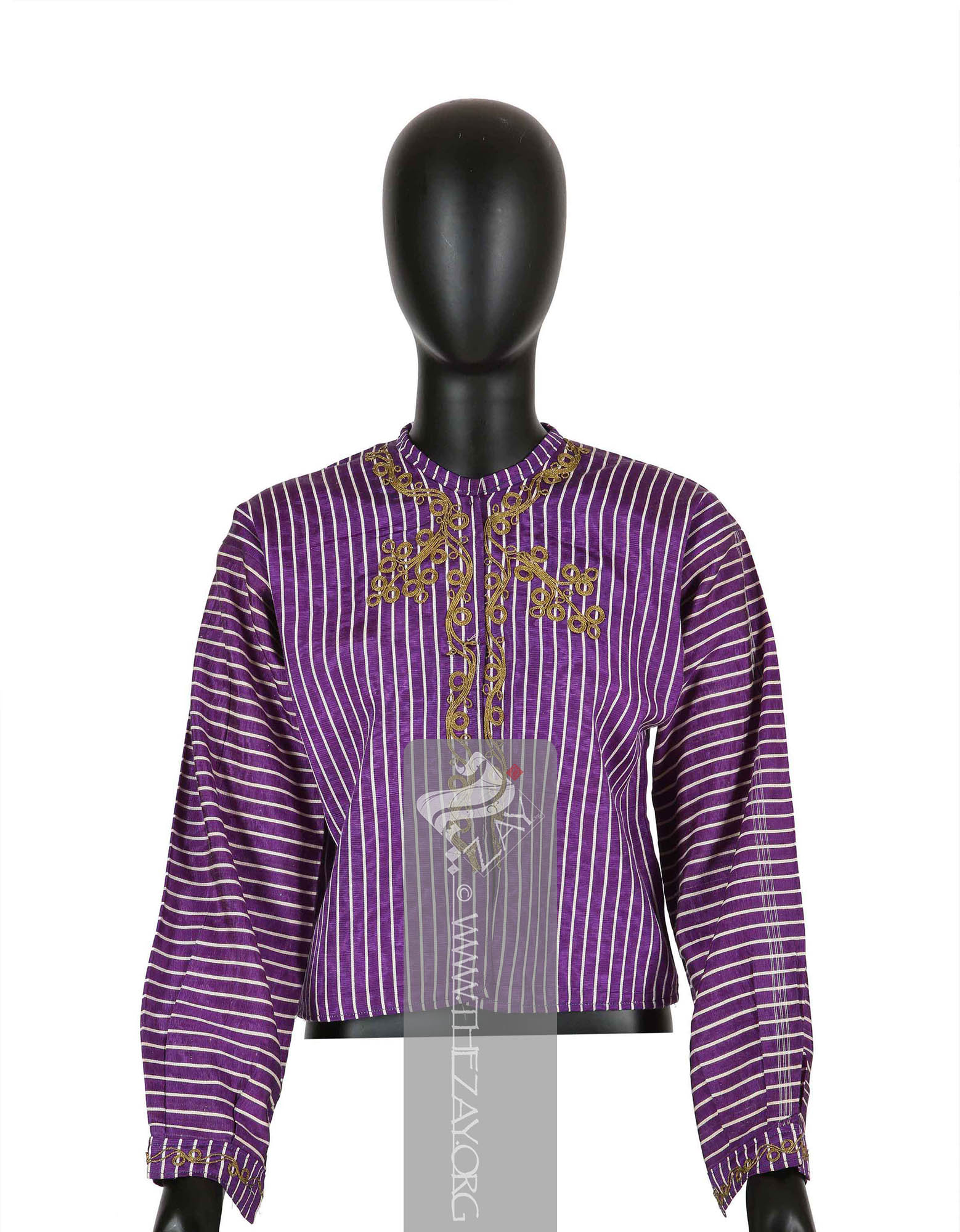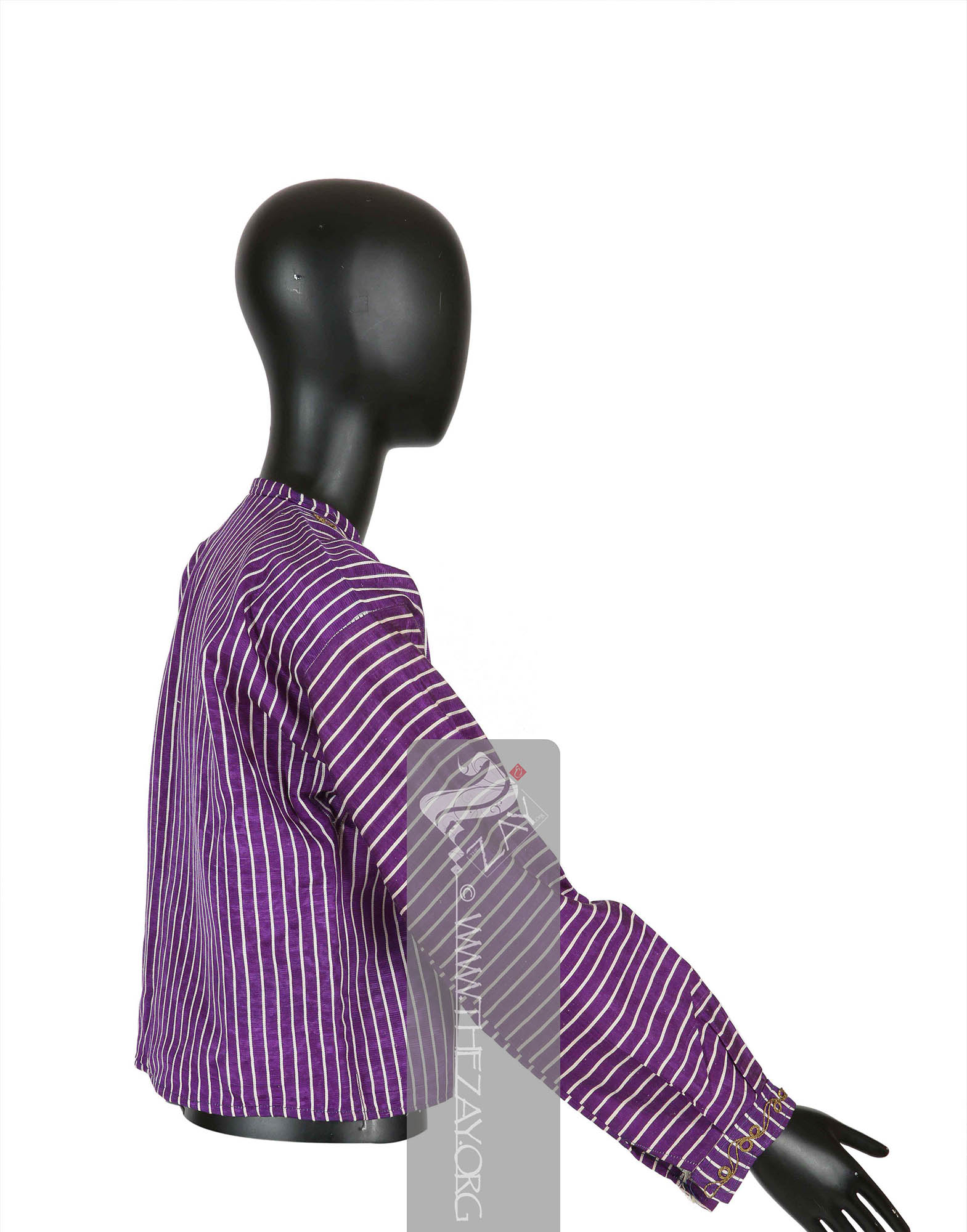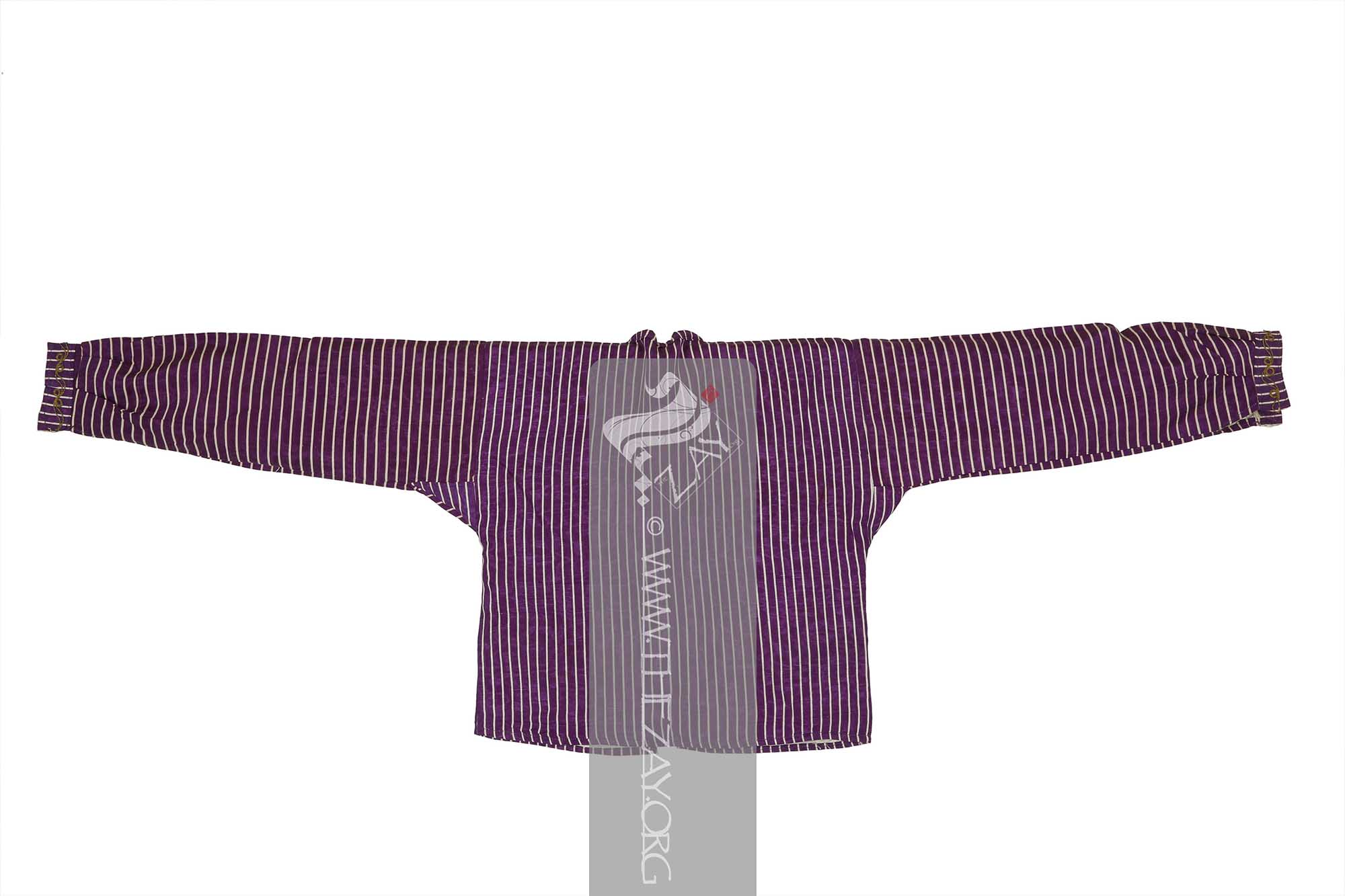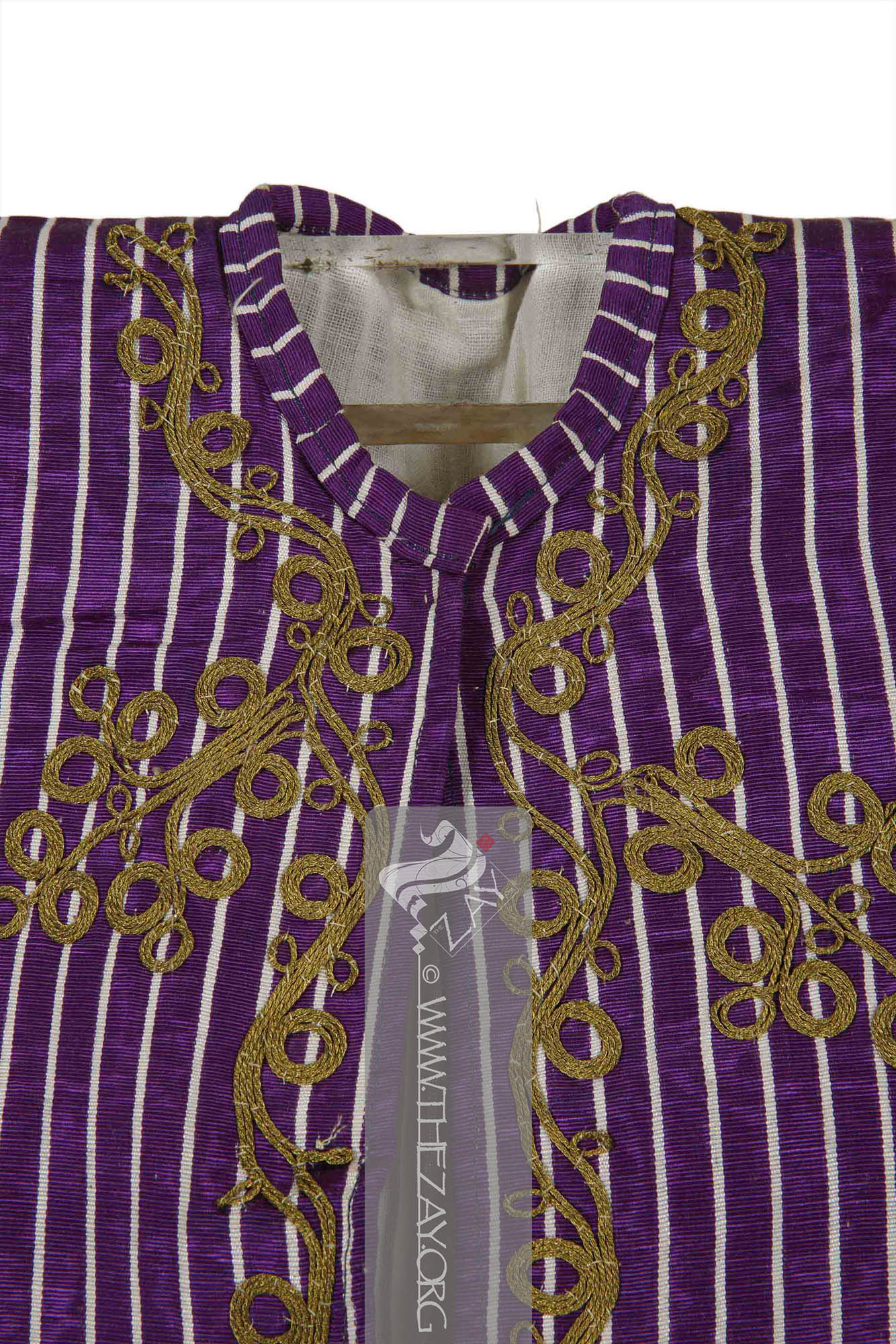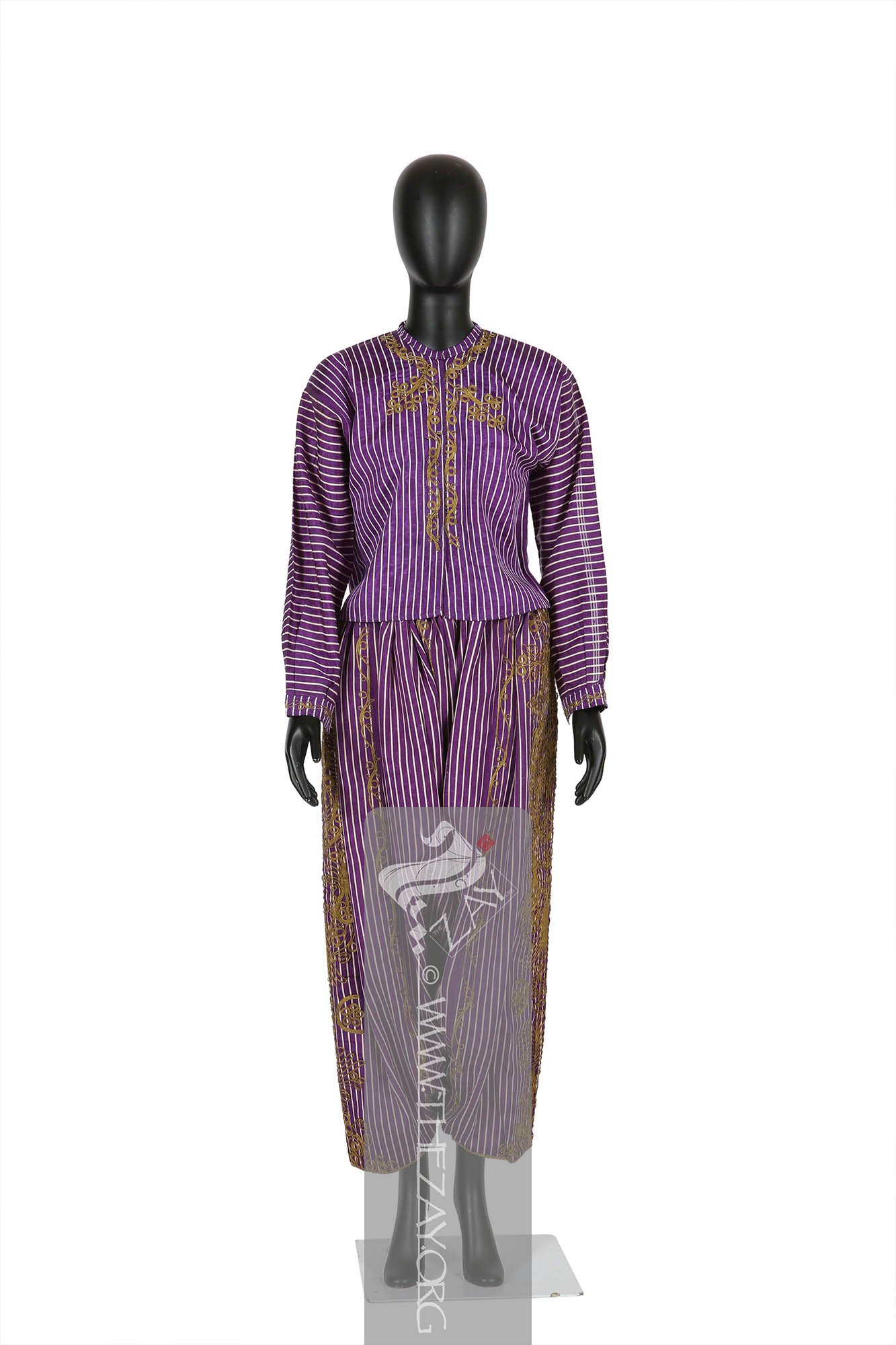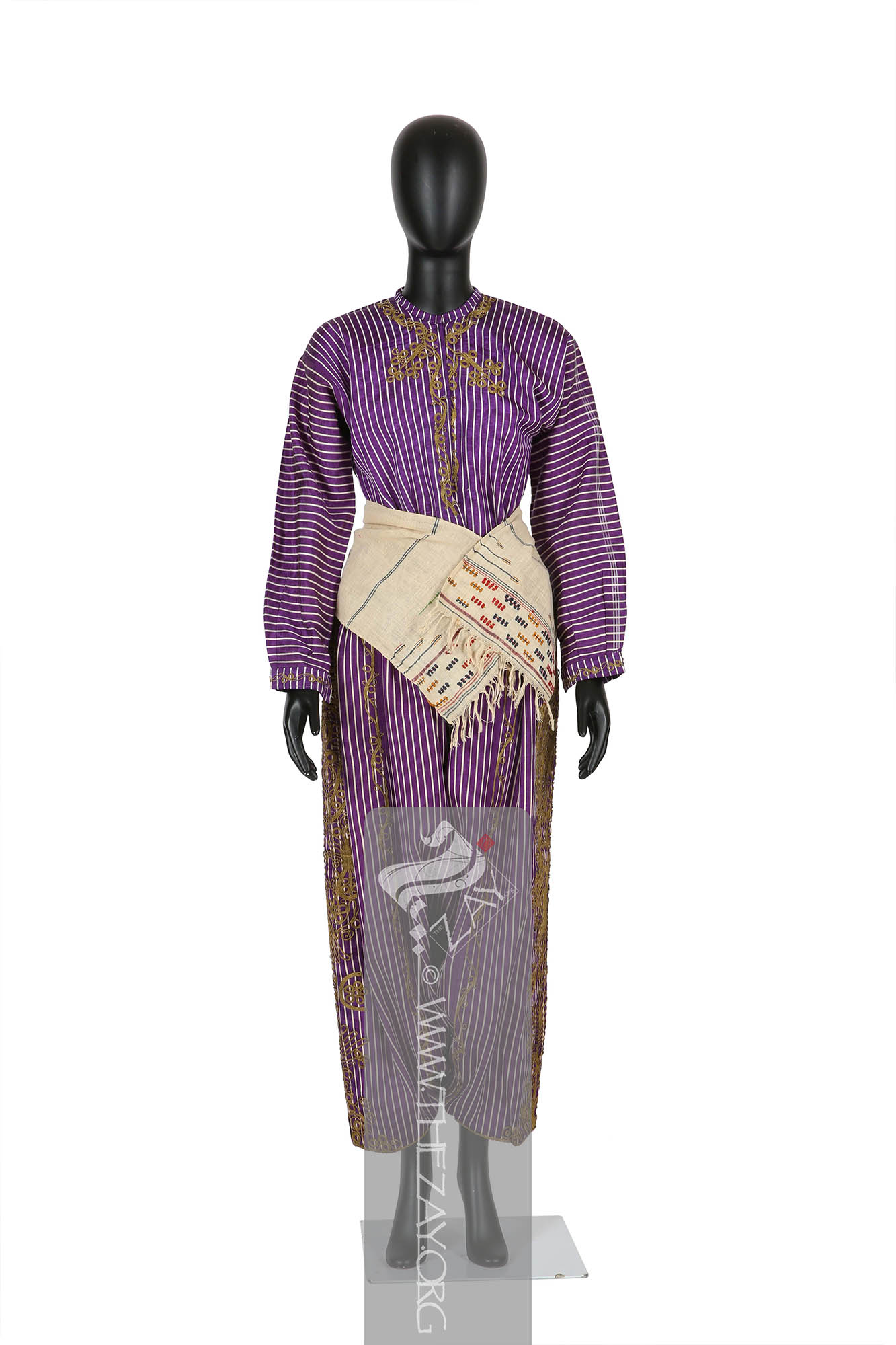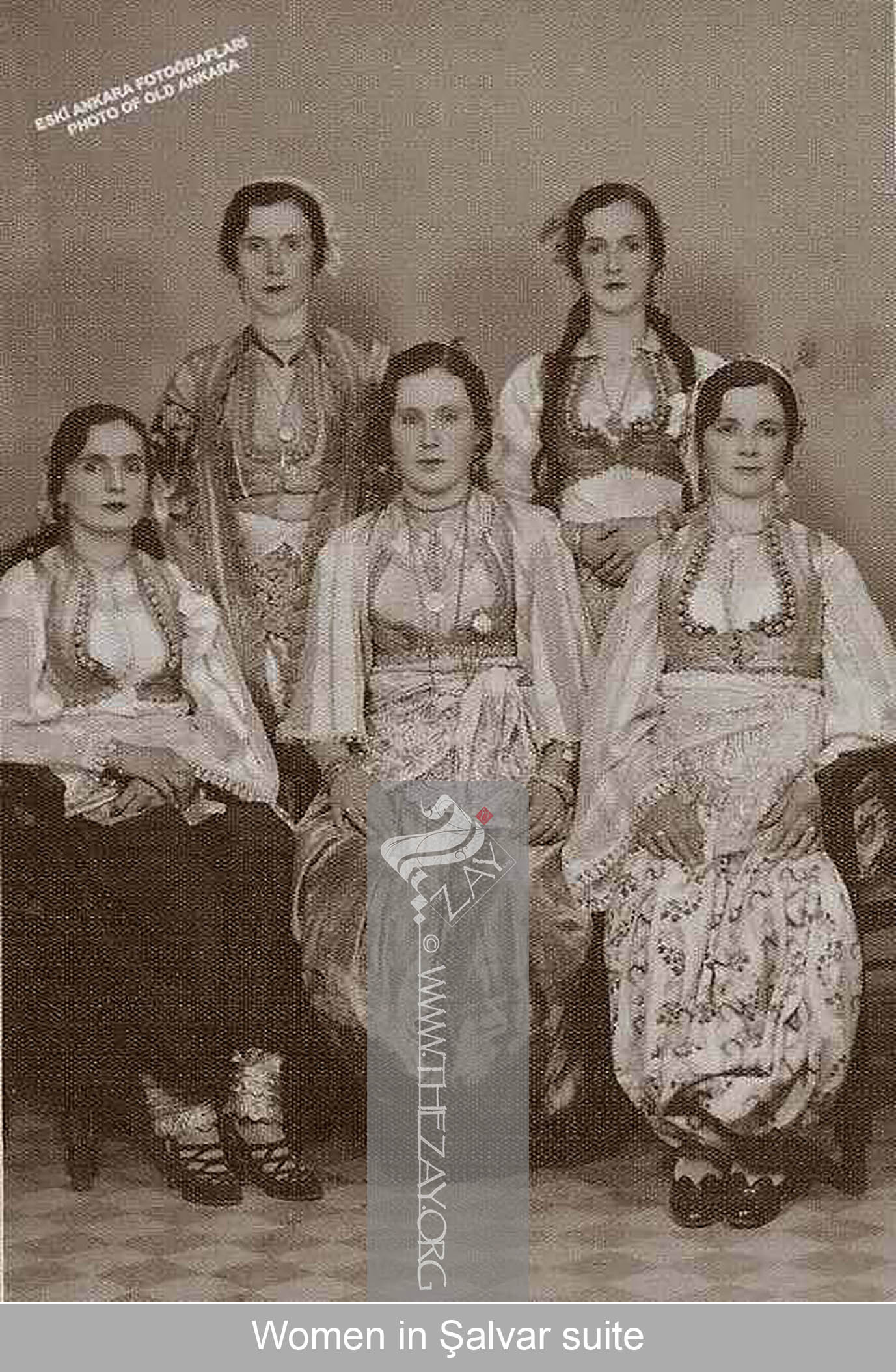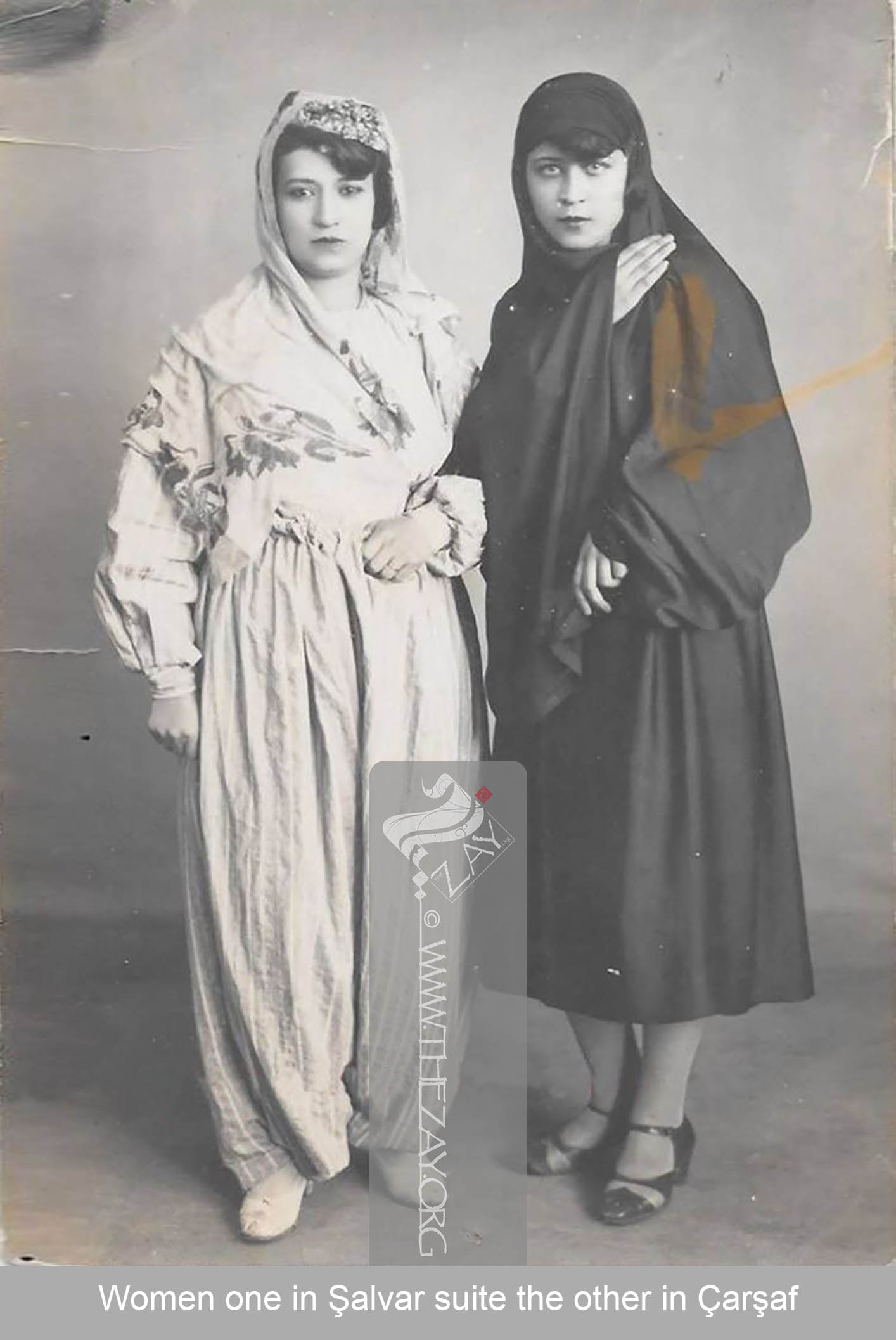Object NotePart of an ensemble with two other pieces also part of the collection (
ZI2021.500875.1a ASIA and
ZI2021.500875.1b ASIA).
Object History This piece of garment was purchased by
Dr. Reem Tariq
Ṭariq: (Arabic; Synonym: tulle_bi_talli
Tūlle_bi_tallī: (French: Tulle – a city in France where fine material for veil was first made; Turkish: tel – wire; Synonym: tariq; talli; badla; khus_dozi ), series of small metal knots made on a woven net ground as embellishment. The term is commonly used in the North African Arab region specifically in Egypt.
; talli; badla; khus_dozi ), series of small metal knots made on a woven net ground as embellishment. The term is commonly used in the Levant Arab region specifically in Lebanon.
El Mutwalli
Dr. Reem Tariq
Ṭariq: (Arabic; Synonym: tulle_bi_talli
Tūlle_bi_tallī: (French: Tulle – a city in France where fine material for veil was first made; Turkish: tel – wire; Synonym: tariq; talli; badla; khus_dozi ), series of small metal knots made on a woven net ground as embellishment. The term is commonly used in the North African Arab region specifically in Egypt.
; talli; badla; khus_dozi ), series of small metal knots made on a woven net ground as embellishment. The term is commonly used in the Levant Arab region specifically in Lebanon.
el Mutwallī: Founder (CEO) of the Zay
Zay: (Arabic: costume, Pl. azyaā’), a set of clothes in a style typical of a particular country or historical period. Initiative, a public figure, speaker and author. An expert curator and consultant in Islamic art and architecture, interior design, historic costume, and UAE heritage. as a set of ensembles from a dealer, in Istanbul in 2020 to add to and enhance The
Zay
Zay: (Arabic: costume, Pl. azyaā’), a set of clothes in a style typical of a particular country or historical period. Initiative Collection.
Object Features This is a purple and ivory vertical striped silk waistcoat with metal – possibly gold – thread (
sirma
Sirma: (Byzantine Greek: súrma – a dragging motion, from Ancient Greek: súrō – to draw; Synonym: Tel_sirma
Tel_sirma: (Ottoman Turkish: tel – wire, thread, chord; Byzantine Greek: súrma – a dragging motion from Ancient Greek: súrō – to draw; Synonym: Sirma), a metal lace or thread traditionally made of silver or gold and sometimes even copper often used textile embellishments such as embroidery and weaves like brocades. ), a metal lace or thread traditionally made of silver or gold and sometimes even copper often used textile embellishments such as embroidery and weaves like brocades. )/(
tel_sirma
Tel_sirma: (Ottoman Turkish: tel – wire, thread, chord; Byzantine Greek: súrma – a dragging motion from Ancient Greek: súrō – to draw; Synonym: Sirma), a metal lace or thread traditionally made of silver or gold and sometimes even copper often used textile embellishments such as embroidery and weaves like brocades. ) embroidered embellishment.
The field of the jacket is constructed of silk and cotton stripe patterned woven (çitari) fabric. A front open waistcoat, the front panels of the
yoke
Yoke: (Synonym: Bodice_Yoke), a structured pattern fitted at the shoulders defining the structure of women’s garments. Introduced in c. 1880s it defines the transition between the upper and lower parts of the garments and can now be found stitched-in where the blouse is separated from the skirt by a horizontal seam. are embroidered using possibly gold
sirma
Sirma: (Byzantine Greek: súrma – a dragging motion, from Ancient Greek: súrō – to draw; Synonym: Tel_sirma
Tel_sirma: (Ottoman Turkish: tel – wire, thread, chord; Byzantine Greek: súrma – a dragging motion from Ancient Greek: súrō – to draw; Synonym: Sirma), a metal lace or thread traditionally made of silver or gold and sometimes even copper often used textile embellishments such as embroidery and weaves like brocades. ), a metal lace or thread traditionally made of silver or gold and sometimes even copper often used textile embellishments such as embroidery and weaves like brocades. in (
couching
Couching: (Latin: collocare – Place together), in needlework and embroidery couching is a technique in which yarn or other materials are laid across the surface of the ground fabric and fastened in place with small stitches of the same or a different yarn
) style featuring loops and waves to form floral and geometric patterns.
There are two metal tab buttons along the placket for fastening it in the front. A similar design reflects on the cuffs and around the front neckline of the piece too. The sleeves are tapered and gathered at the cuffs with pleats.
The design around the neckline is placed along the collar bones of the wearer which extends diagonally inwards like embroidered lapels. The piece is lined with a fine ivory cotton fabric.
Although a fairly recent piece dating back to the 1970s, it has been constructed like the traditional garments prevalent during the Ottoman rule, especially during the 19th century.
Prior to the widespread acceptance of European clothing in the Ottoman Empire, individuals – men and women – residing in urban areas, regardless of their faith or social standing, typically adorned themselves with three primary articles of clothing.
These included a calf-length cotton undershirt or (
gömlek
Gömlek: (Proto-Turkic: köyŋelek – Shirt; Azerbaijani: köynək – Shirt; Turkmen: koynek
Koynek: A traditional long, loose-fitting tunic or dress worn by Turkmen women in Central Asia typically made of silk or cotton, adorned with intricate embroidery, and often characterized by vibrant colours and geometric patterns. It is cultural symbol of significant importance reflecting the artistic heritage of Turkmen people. – long loose tunic dress), a traditional calf-length sleeved undershirt or tunic generally made of a plain white cotton, silk, or linen fabric, some more lightweight than others, worn by both Ottoman men and women of all communities throughout the empire.
), featuring long sleeves, which was worn over a pair of loose trousers known as (
shalvar
shalvār: in Farsi, in the Emirati colloquial: ṣarwāl. In the Levantine colloquial: Shirwāl. Plural: sarāwīl, ṣarāwīl, sharāwīl, ṣarwīlāt). It is loose pants at the waist with folds, and narrow at the ankles. It is tied with a rope at the waist.). Additionally, they would wear a long-sleeved robe called an
entari
: (Turkish; Synonym: Antari), a traditional Turkish long jacket-like unisex garment worn during the Ottoman era. It often featured an open front with long sleeves and was worn over an undershirt and a pair of trousers and was sometimes layered by a short waist or hip-length jacket. , reaching the ankles or floor.
Additional layers were added as necessary, based on weather conditions, social occasions, and social status. These layers encompassed items such as waistcoats (
cepken
Cepken: (Tartar: çepken – Outerwear; Synonyms: Shepken, Chekman, Chikmyan and other analogues in various Turkic languages with varied interpretations), short waist-length jacket traditionally worn by both Ottoman men and women throughout the empire. It usually featured full sleeves, elaborate embroidery, and a short stiff collar with front fastenings. ), short jackets (
yelek
Yelek: (Old Anatolian: yélek – Vest; Synonyms: Jelick, Jilek), short waist or hip length vest traditionally worn by both Ottoman men and women throughout the empire. Ranging from sleeveless to full sleeves, these vests were usually front open and without any fastenings. Often cepken jackets were used as yelek. ) or (
jilek
Jilek: (Old Anatolian: yélek – Vest; Synonyms: Jelick, Yelek
Yelek: (Old Anatolian: yélek – Vest; Synonyms: Jelick, Jilek), short waist or hip length vest traditionally worn by both Ottoman men and women throughout the empire. Ranging from sleeveless to full sleeves, these vests were usually front open and without any fastenings. Often cepken jackets were used as yelek. ), a short waist or hip length vest traditionally worn by both Ottoman men and women throughout the empire. Ranging from sleeveless to full sleeves, these vests were usually front open and without any fastenings. Often cepken jackets were used as yelek
Yelek: (Old Anatolian: yélek – Vest; Synonyms: Jelick, Jilek), short waist or hip length vest traditionally worn by both Ottoman men and women throughout the empire. Ranging from sleeveless to full sleeves, these vests were usually front open and without any fastenings. Often cepken jackets were used as yelek. . ), extra
entari
: (Turkish; Synonym: Antari), a traditional Turkish long jacket-like unisex garment worn during the Ottoman era. It often featured an open front with long sleeves and was worn over an undershirt and a pair of trousers and was sometimes layered by a short waist or hip-length jacket. , as well as coats of various sizes and lengths. Belts adorned with elaborate embroidery and ornate buckles, or just embroidered sashes as (
cummerbund
Cummerbund: (Anglicized from Hindustani: kamarband
kamarband: (Persian: kamarband – a waistband or sash tied around the waist, synonym: cummerbund), a broad sash worn around the waist by men. In the 17th century, the British Indian Army adopted this style from the Indian sepoys and made it a part of the English lexicon. from Persian: kamarband
kamarband: (Persian: kamarband – a waistband or sash tied around the waist, synonym: cummerbund), a broad sash worn around the waist by men. In the 17th century, the British Indian Army adopted this style from the Indian sepoys and made it a part of the English lexicon. – a waistband or sash tied around the waist), a broad sash worn around the waist by men. In the 17th century the British Indian Army adopted this style from the Indian sepoys and made it a part of the English lexicon. ) were utilized to accentuate the bust, waist, and hips, creating a defined silhouette.
Although, the
entari
: (Turkish; Synonym: Antari), a traditional Turkish long jacket-like unisex garment worn during the Ottoman era. It often featured an open front with long sleeves and was worn over an undershirt and a pair of trousers and was sometimes layered by a short waist or hip-length jacket. was common throughout the Ottoman Empire, layering with a
cepken
Cepken: (Tartar: çepken – Outerwear; Synonyms: Shepken, Chekman, Chikmyan and other analogues in various Turkic languages with varied interpretations), short waist-length jacket traditionally worn by both Ottoman men and women throughout the empire. It usually featured full sleeves, elaborate embroidery, and a short stiff collar with front fastenings. and a
yelek
Yelek: (Old Anatolian: yélek – Vest; Synonyms: Jelick, Jilek), short waist or hip length vest traditionally worn by both Ottoman men and women throughout the empire. Ranging from sleeveless to full sleeves, these vests were usually front open and without any fastenings. Often cepken jackets were used as yelek. over a
gömlek
Gömlek: (Proto-Turkic: köyŋelek – Shirt; Azerbaijani: köynək – Shirt; Turkmen: koynek
Koynek: A traditional long, loose-fitting tunic or dress worn by Turkmen women in Central Asia typically made of silk or cotton, adorned with intricate embroidery, and often characterized by vibrant colours and geometric patterns. It is cultural symbol of significant importance reflecting the artistic heritage of Turkmen people. – long loose tunic dress), a traditional calf-length sleeved undershirt or tunic generally made of a plain white cotton, silk, or linen fabric, some more lightweight than others, worn by both Ottoman men and women of all communities throughout the empire.
and a pair of loose
shalvar
shalvār: in Farsi, in the Emirati colloquial: ṣarwāl. In the Levantine colloquial: Shirwāl. Plural: sarāwīl, ṣarāwīl, sharāwīl, ṣarwīlāt). It is loose pants at the waist with folds, and narrow at the ankles. It is tied with a rope at the waist. was most common in the Balkan regions, an influence that widely spread through the rest of the Ottoman Empire and was especially popular in c. late 19th and early 20th centuries in the north-western provinces such as the Marmara region in present-day Türkiye, as it had a significant Balkan population.
More InfoThe intriguing history of çitari fabric unfolds within the Turkish diaspora during the 18th-century Ottoman era when other various novel fabrics gained prominence.
Distinguished by its unique attributes, this fabric features slender, parallel vertical stripes in contrasting colours, reminiscent of the strings of a musical instrument called the çitar.
Composed of tightly woven silk (
warp
Warp: One of the two basic components used in weaving which transforms thread or yarns to a piece of fabric. The warp is the set of yarns stretched longitudinally in place on a loom before the weft
Weft: one of the two basic components used in weaving that transforms thread or yarns into a piece of fabric. It is the crosswise thread on a loom that is passed over and under the warp threads. is introduced during the weaving process. ) and cotton (
weft
Weft: one of the two basic components used in weaving that transforms thread or yarns into a piece of fabric. It is the crosswise thread on a loom that is passed over and under the warp threads.) yarns, the çitari fabric stands apart from other striped textiles due to its specific weaving technique, coloured
warp
Warp: One of the two basic components used in weaving which transforms thread or yarns to a piece of fabric. The warp is the set of yarns stretched longitudinally in place on a loom before the weft
Weft: one of the two basic components used in weaving that transforms thread or yarns into a piece of fabric. It is the crosswise thread on a loom that is passed over and under the warp threads. is introduced during the weaving process. patterns, choice of raw materials, and superior craftsmanship.
Notably, regions such as Bursa, Gaziantep, Istanbul, Tunceli, Diyarbakir, Tokat, Antalya, Harput, Yalvaç, Izmir, and Denizli were renowned for their exquisite çitari weaves during this period. Such was the fabric's popularity that it even led to the importation of çitari from India and Damascus.
As such The
Zay
Zay: (Arabic: costume, Pl. azyaā’), a set of clothes in a style typical of a particular country or historical period. Initiative has in its possession pieces that were constructed of similar fabric that were sourced from the Levant region of the Arab world, especially Palestine and Syria. One such piece worth mentioning is a tunic dress from Palestine – ZI1998.500922 PALESTINE.
At its peak, the Ottoman Empire spanned three continents and served as the crossroads between the east and the West – the Fertile Crescent, the Levant, Eastern Europe including the Balkans till the southern edge of the Great Hungarian Plain, Northern Africa and Eastern Mediterranean.
After the conquest of the Arab world in c. 1516-1517 CE its control over the Middle East lasted for four centuries until the early 20th century with the onset of WW I and the Arab Revolt.
These four hundred years witnessed many instances of mutual Arab and Ottoman cultural influences and exchanges.
Through areas such as social life and art – decorative and performing –we come across several instances of Arab and Turkish culture blending together through the centuries.
Just as European fashion was often inspired by the French court this socio-cultural blending between Ottoman Turkey and the Middle East was clearly reflected in its fashion and material culture.
Thus, while emulating Ottoman fashion as the mark of class in the Arab world was one side of the puzzle adapting Eastern European fashion particularly Balkan as part of mainstream couture culture because of the sizeable Balkan population within the Empire was another. Therefore, it is not surprising to find several articles of clothing and their terms similar between these cultures.
Links
- Cangökçe, Hadiye, et al. Osmanlı İmparatorluğu’nun Son Döneminden Kadın Giysileri = Women’s Costume of the Late Ottoman Era from the Sadberk Hanım Museum Collection. Sadberk Hanım Museum, 2010.
- Küçükerman, Önder, and Joyce Matthews. The Industrial Heritage of Costume Design in Turkey. GSD Foreign Trade Co. Inc, 1996.
- AĞAÇ, Saliha, and Serap DENGİN. “The Investigation in Terms of Design Component of Ottoman Women Entari
: (Turkish; Synonym: Antari), a traditional Turkish long jacket-like unisex garment worn during the Ottoman era. It often featured an open front with long sleeves and was worn over an undershirt and a pair of trousers and was sometimes layered by a short waist or hip-length jacket. in 19th Century and Early 20th Century.” International Journal of Science Culture and Sport (IntJSCS), vol. 3, no. 1, Mar. 2015, pp. 113–125. https://dergipark.org.tr/tr/download/article-file/91778
- Parker, Julianne. “OTTOMAN AND EUROPEAN INFLUENCE IN THE NINTEENTH-CENTURY BRIDAL COLLECTION OF THE AZEM PALACE, DAMASCUS, SYRIA.” Journal of Undergraduate Research: Brigham Young University, 18 Sept. 2013. http://jur.byu.edu/?p=6014
- Koç, Adem. “The Significance and Compatibility of the Traditional Clothing-Finery Culture of Women in Kutahya in Terms of Sustainability.” Milli Folklor , vol. 12, no. 93, Apr. 2012. 184. https://www.millifolklor.com/PdfViewer.aspx?Sayi=93&Sayfa=181
- Micklewright, Nancy. “Late-Nineteenth-Century Ottoman Wedding Costumes as Indicators of Social Change.” Muqarnas, vol. 6, 1989, pp. 161–74. JSTOR, https://doi.org/10.2307/1602288. Accessed 13 July 2023.
- Micklewright, Nancy. “Looking at the Pst: Nineteenth Century Images of Constantinople and Historic Documents.” Expedition, vol. 32, no. 1, pp. 24–32. https://www.penn.museum/documents/publications/expedition/pdfs/32-1/micklewright.pdf
- ÇATALKAYA GÖK, Ebru. “Çi̇tari̇Fabric.” TURKISH ONLINE JOURNAL OF DESIGN ART AND COMMUNICATION, vol. 11, no. 2, 2021, pp. 443–453, https://doi.org/10.7456/11102100/008.
- Ozgen, Ozlen, et al. “Henna Ritual Clothing in Anatolia from Past to Present: An Evaluation on Bindalli.” Textile Society of America Symposium Proceedings, 2021, https://doi.org/10.32873/unl.dc.tsasp.0122.
- https://artsandculture.google.com/story/traditional-jewellery-and-dress-from-the-balkans-the-british-museum
- https://www.issendai.com/16thcenturyistanbul/womens-garb-piece-by-piece/yelek
Yelek: (Old Anatolian: yélek – Vest; Synonyms: Jelick, Jilek), short waist or hip length vest traditionally worn by both Ottoman men and women throughout the empire. Ranging from sleeveless to full sleeves, these vests were usually front open and without any fastenings. Often cepken jackets were used as yelek. -kurdiye-cuka-kurk-overcoats/
- https://www.metmuseum.org/art/collection
- https://archive.aramcoworld.com/issue/200703/the.skill.of.the.two.hands
- http://www.turkishculture.org/textile-arts/clothing/womens-garments/womens-garments
- http://jezebeljane.blogspot.com/2015/09/womens-clothing-in-16th-century-turkey
- https://www.issendai.com/16thcenturyistanbul/visual-dictionary/kaftan/
- https://babogenglish.wordpress.com/2016/02/25/turkey-general-information/
- https://ertugrulforever.com/turkish-fashion-2021/
- https://northamericaten.com/turkish-clothing-of-ottoman-times/
- https://www.al-monitor.com/originals/2019/04/turkish-traditional-costumes-from-head-to-toe
- https://reconstructinghistory.com/blogs/blog/an-ottoman-turkish-outfit-part-iii-the-yelek
Yelek: (Old Anatolian: yélek – Vest; Synonyms: Jelick, Jilek), short waist or hip length vest traditionally worn by both Ottoman men and women throughout the empire. Ranging from sleeveless to full sleeves, these vests were usually front open and without any fastenings. Often cepken jackets were used as yelek.




